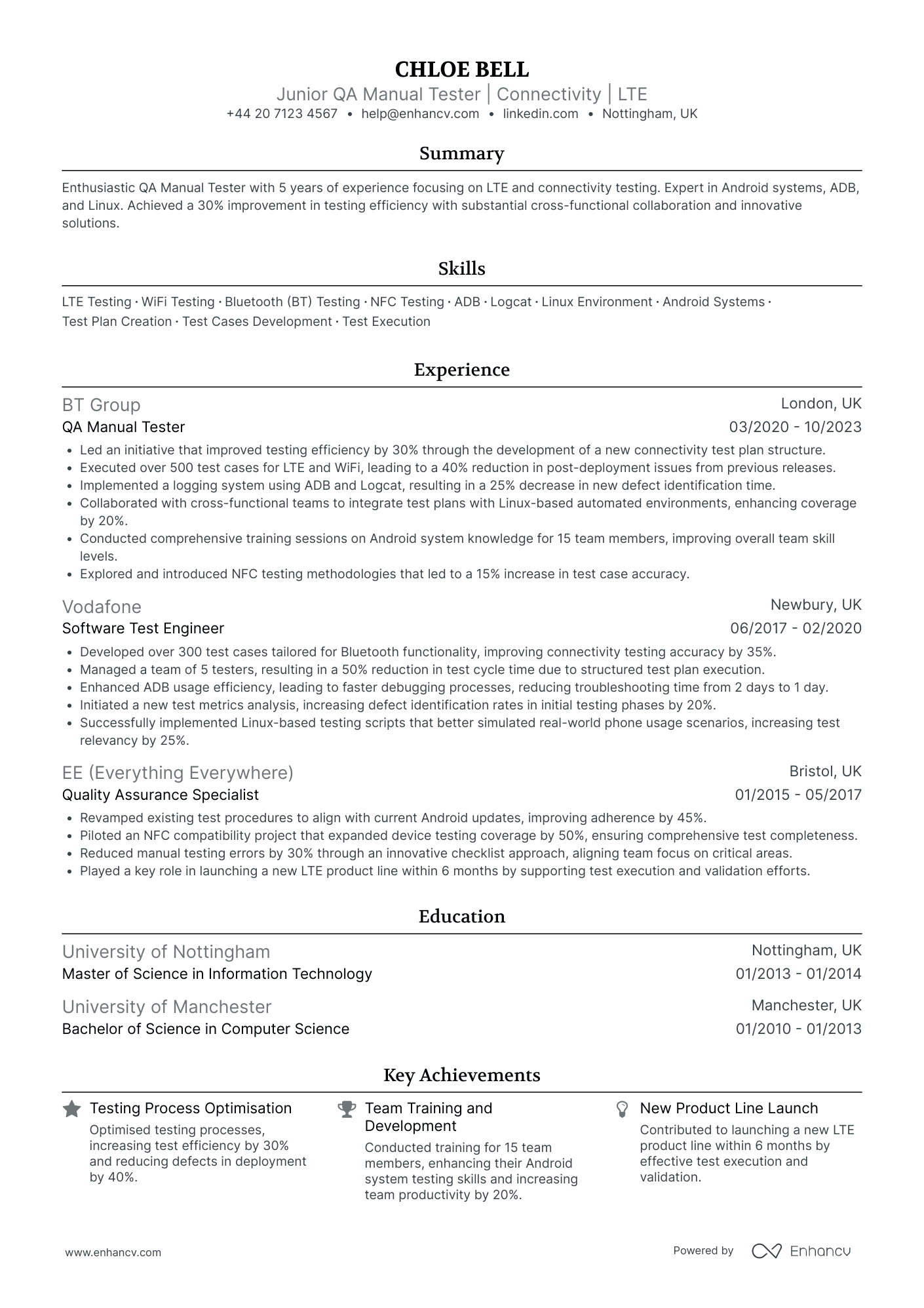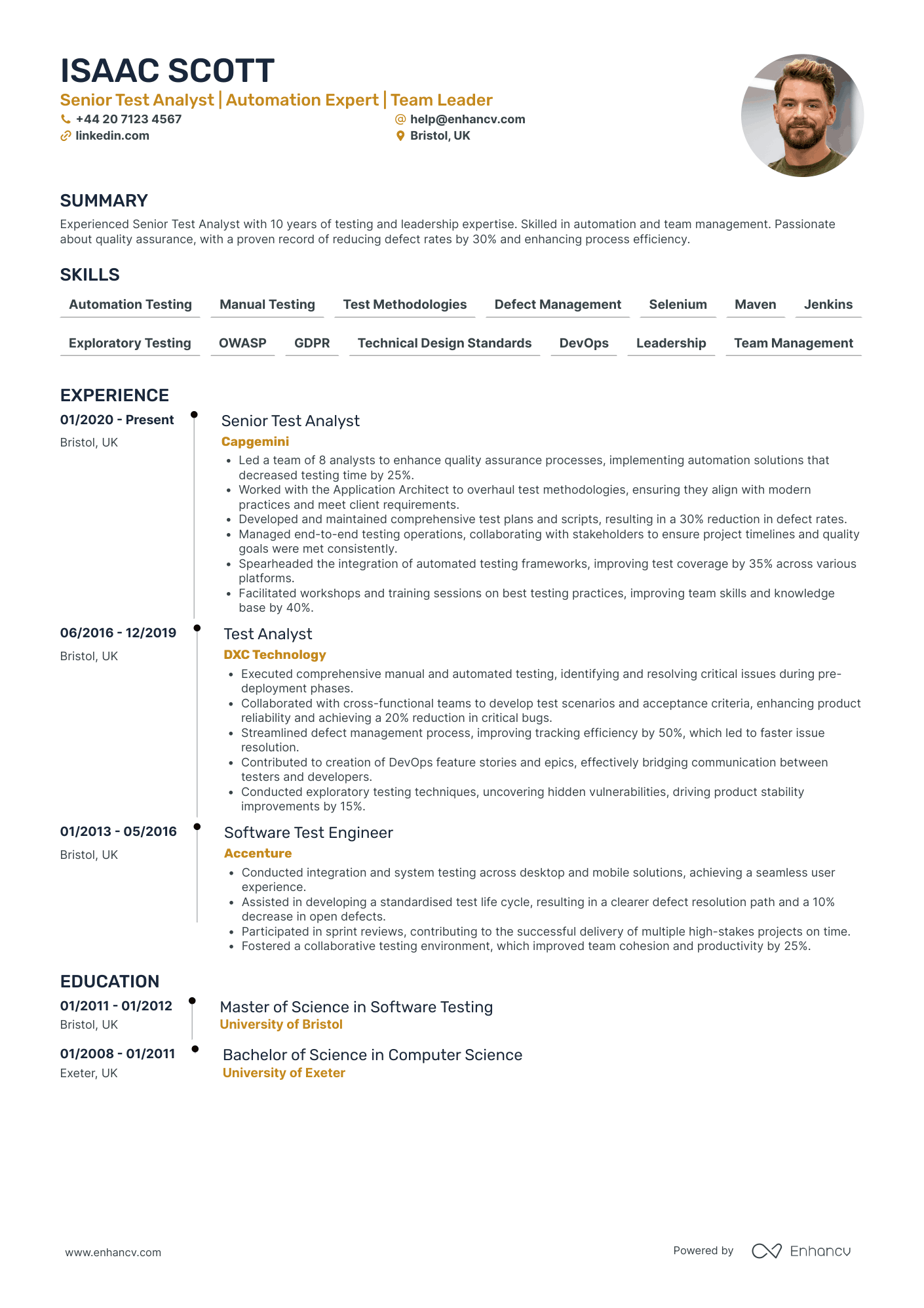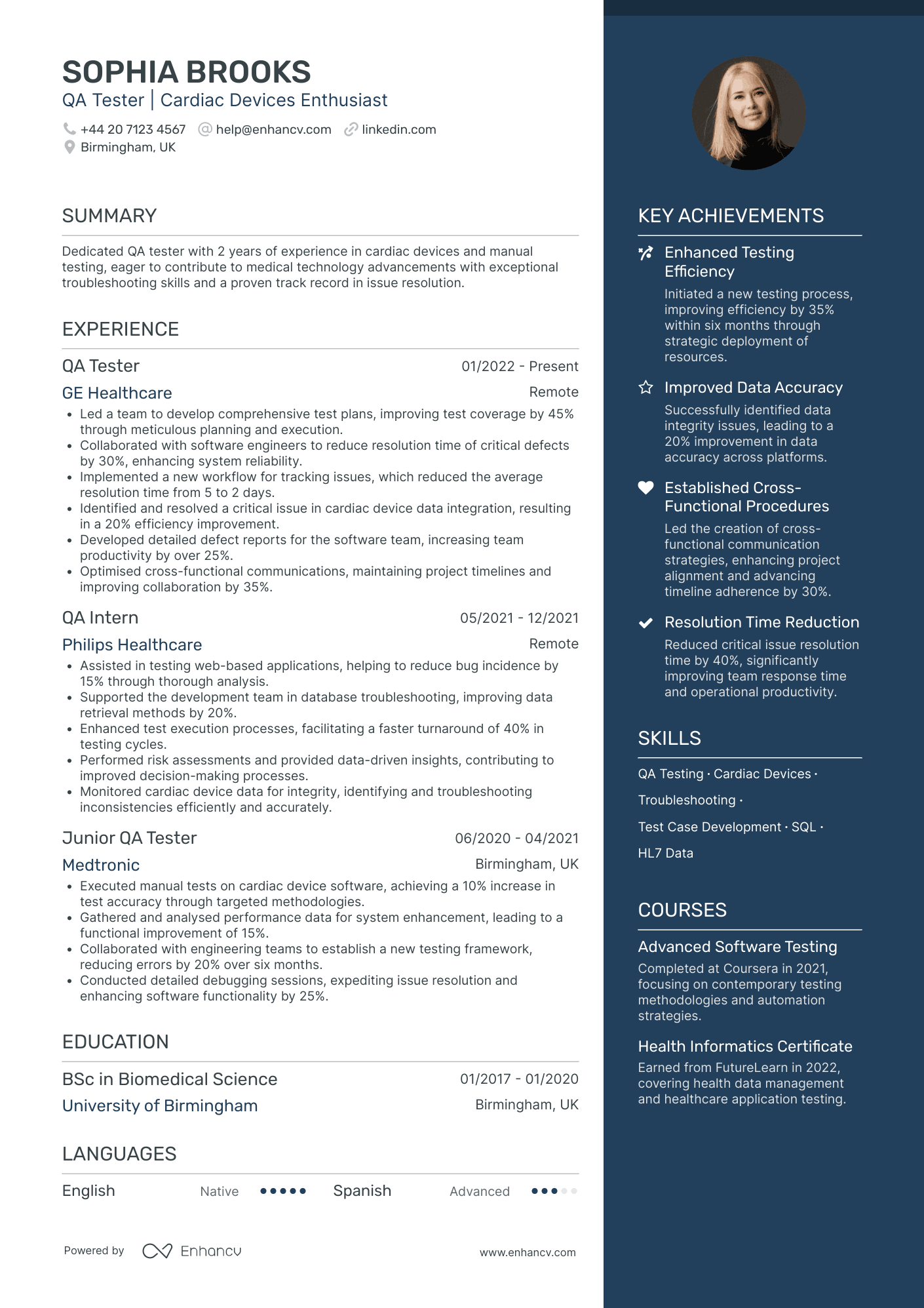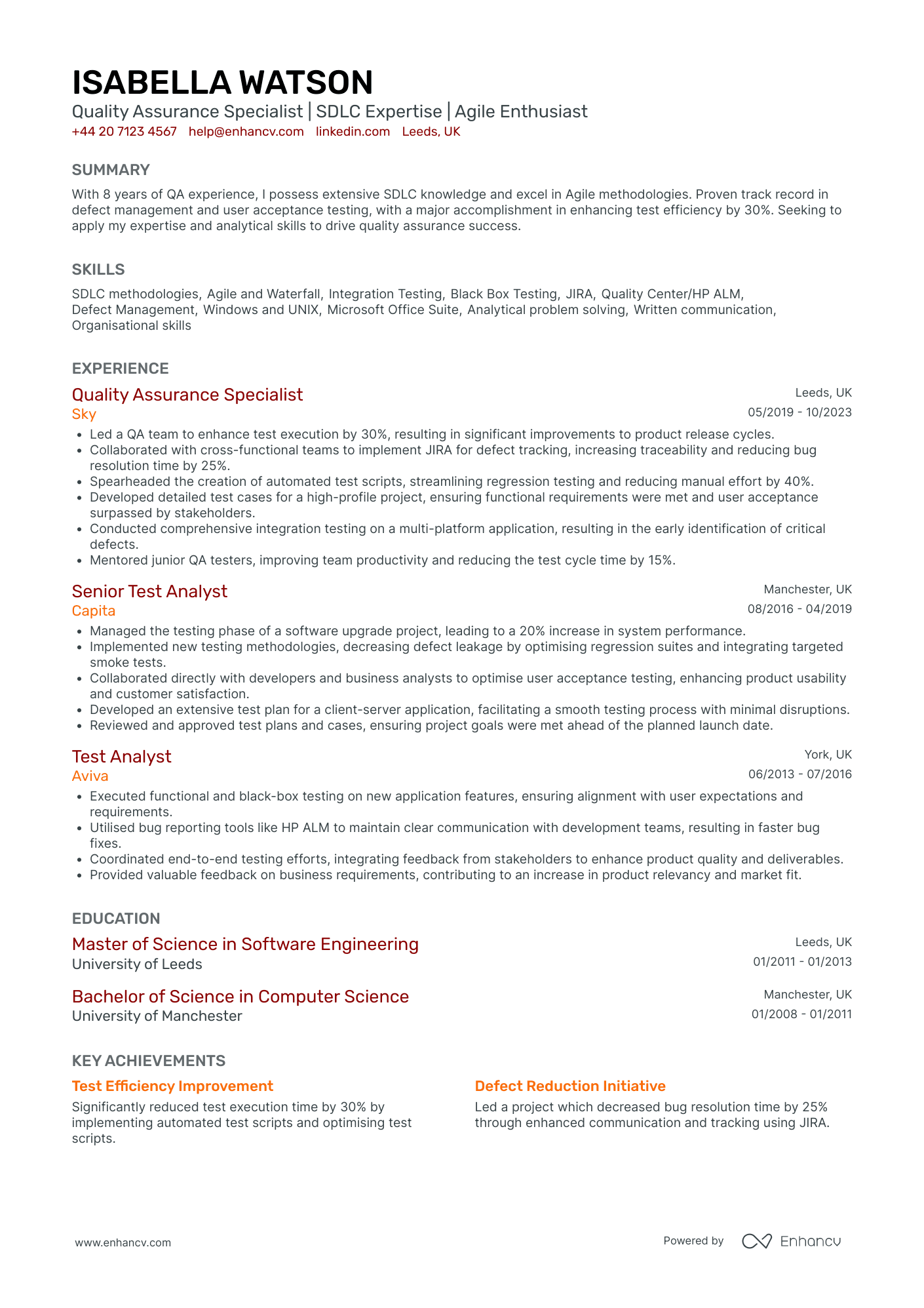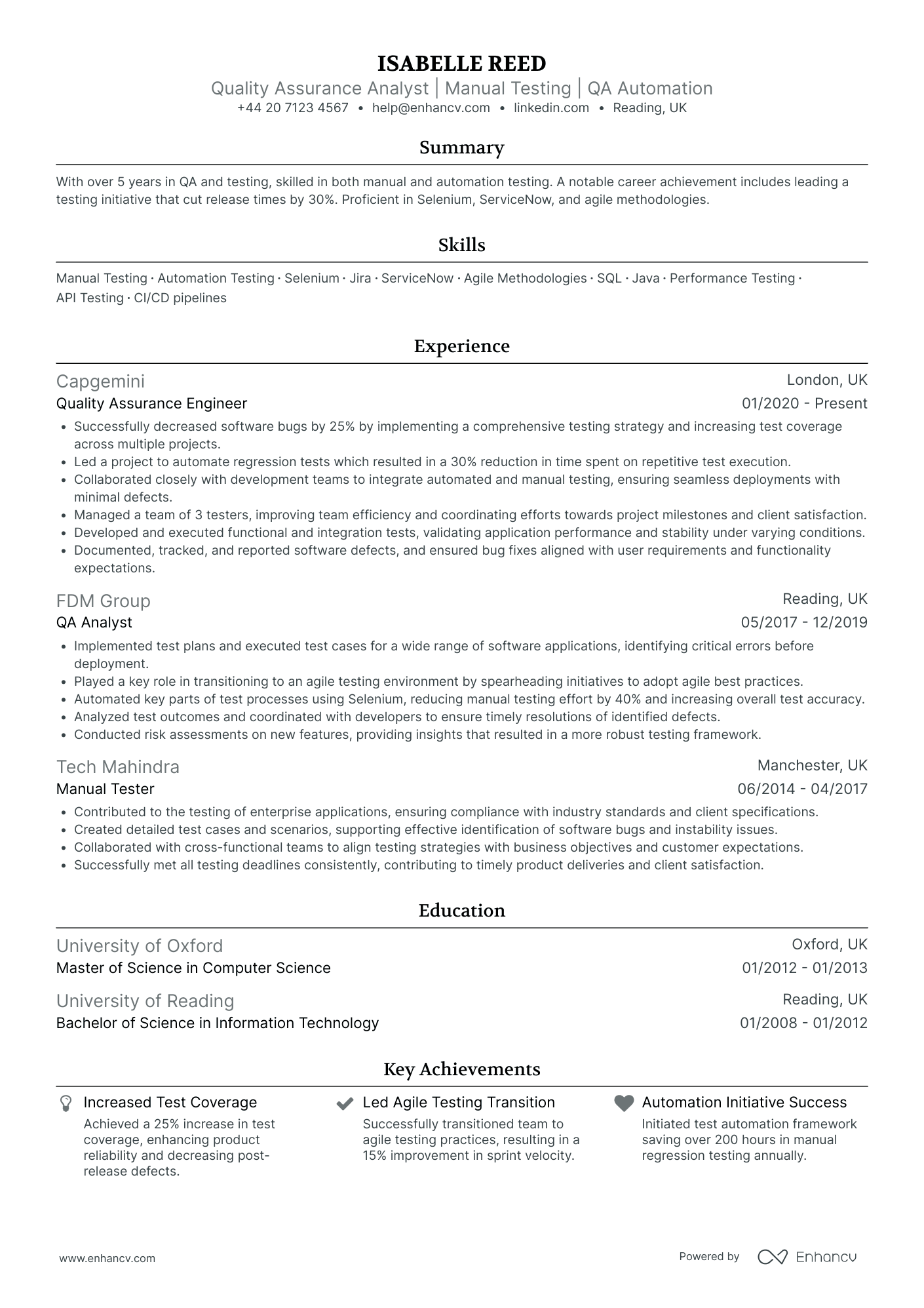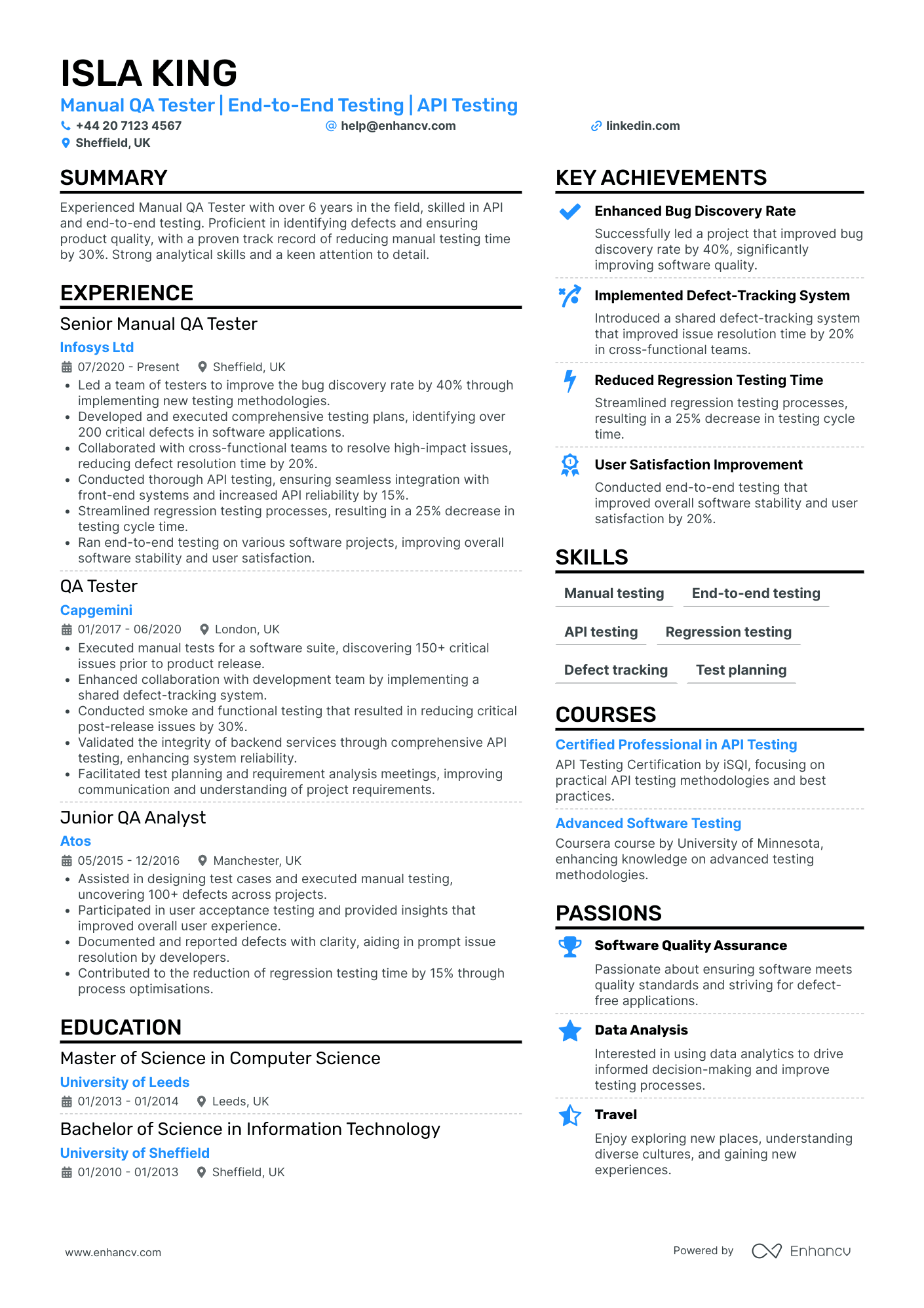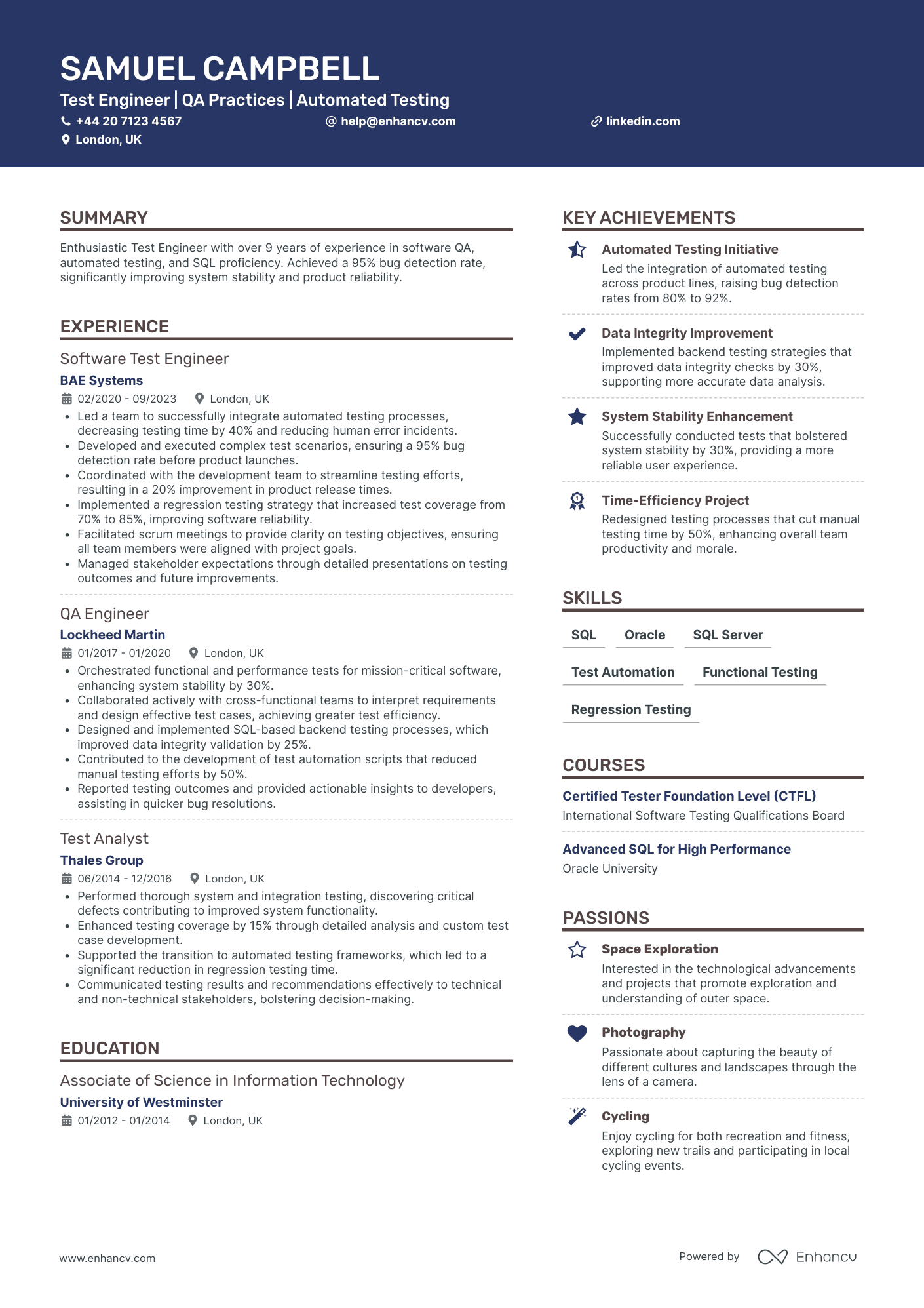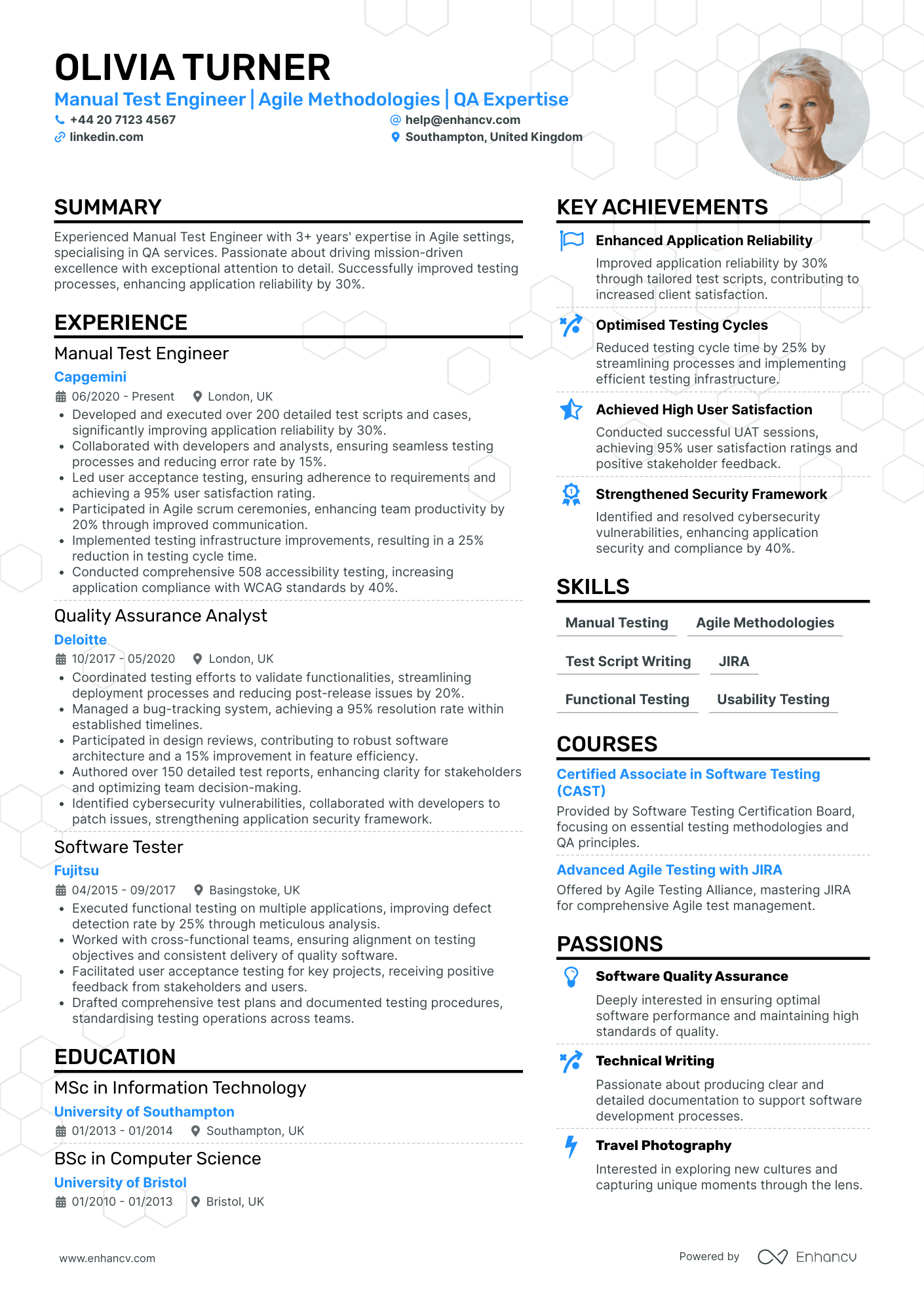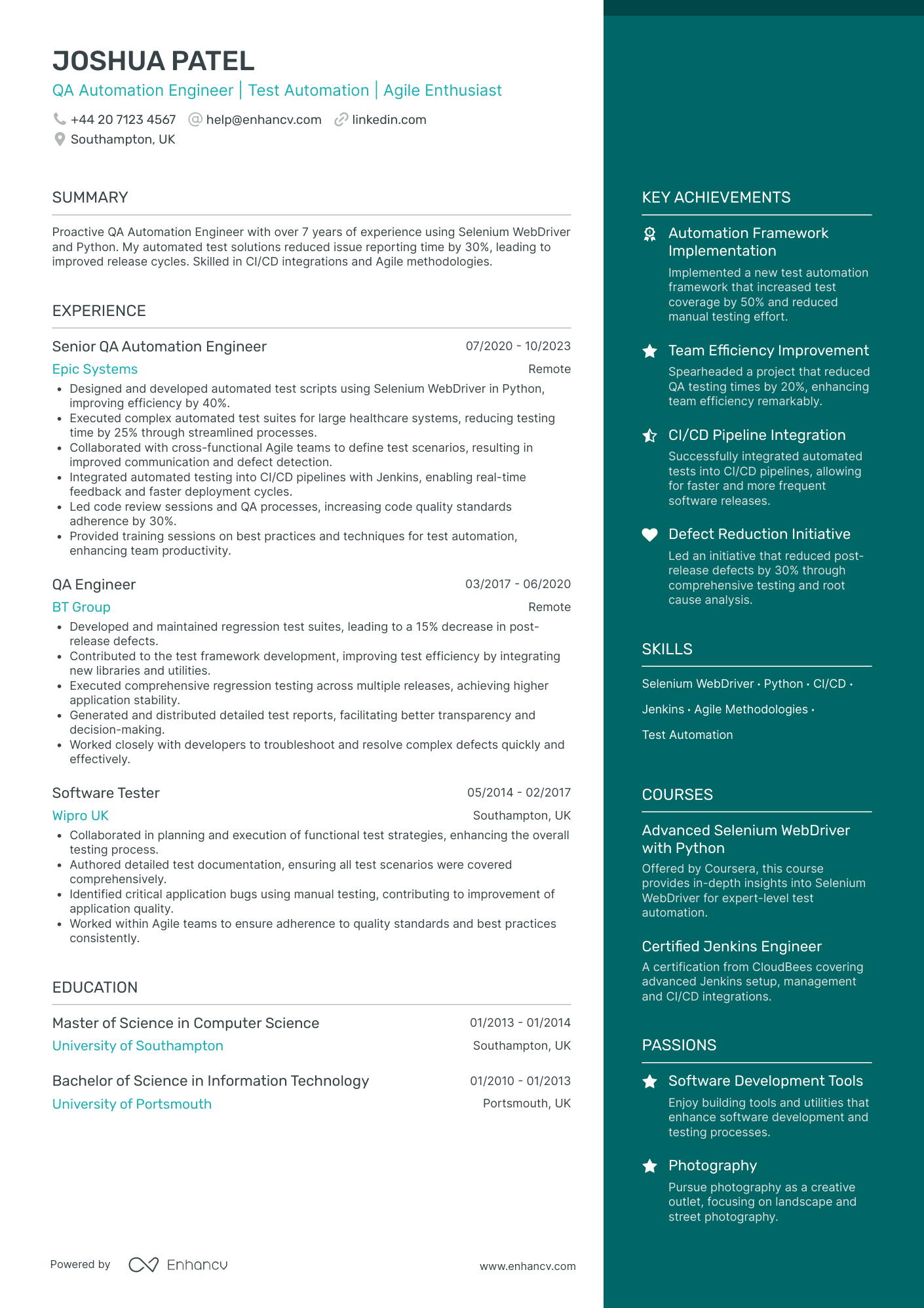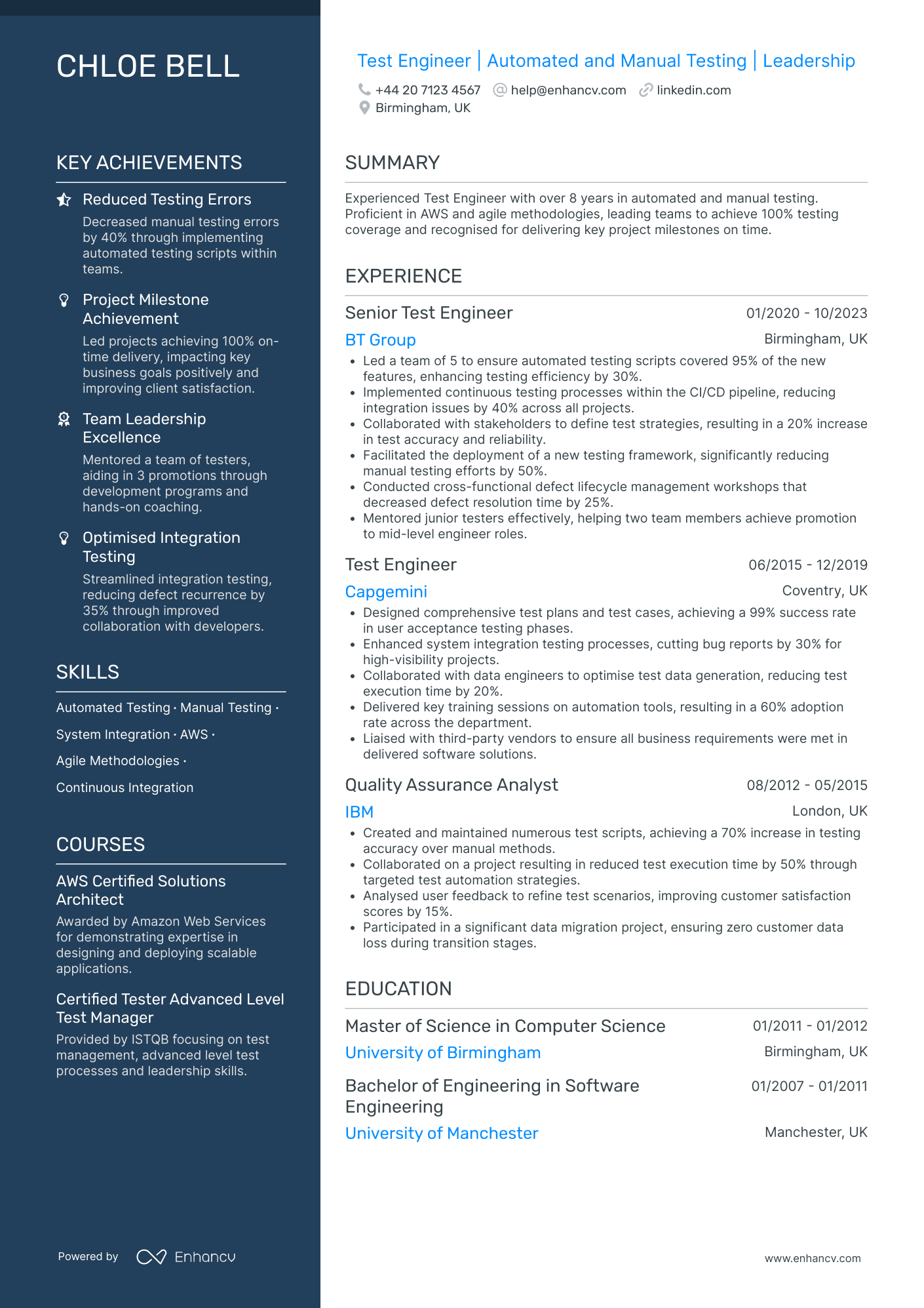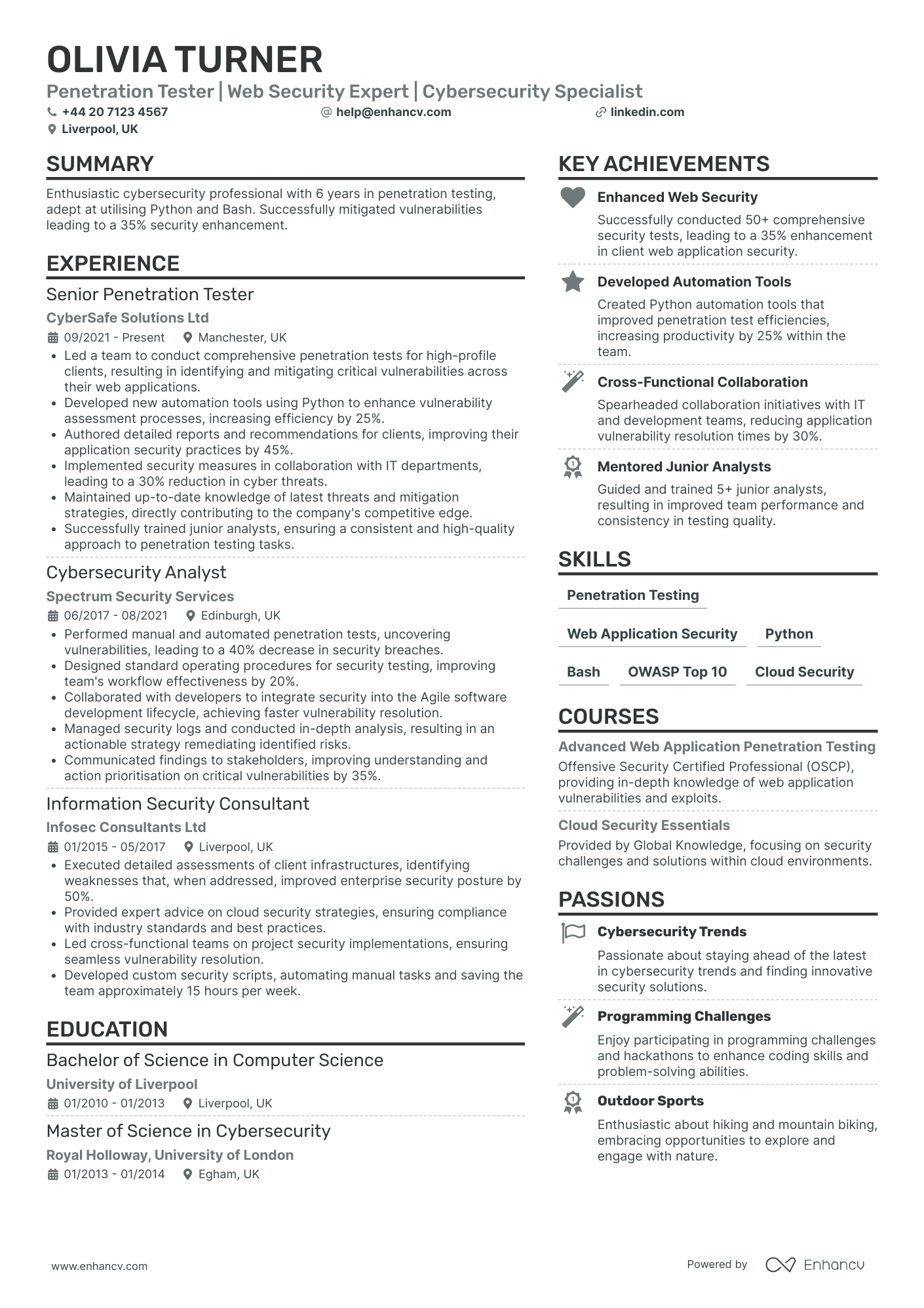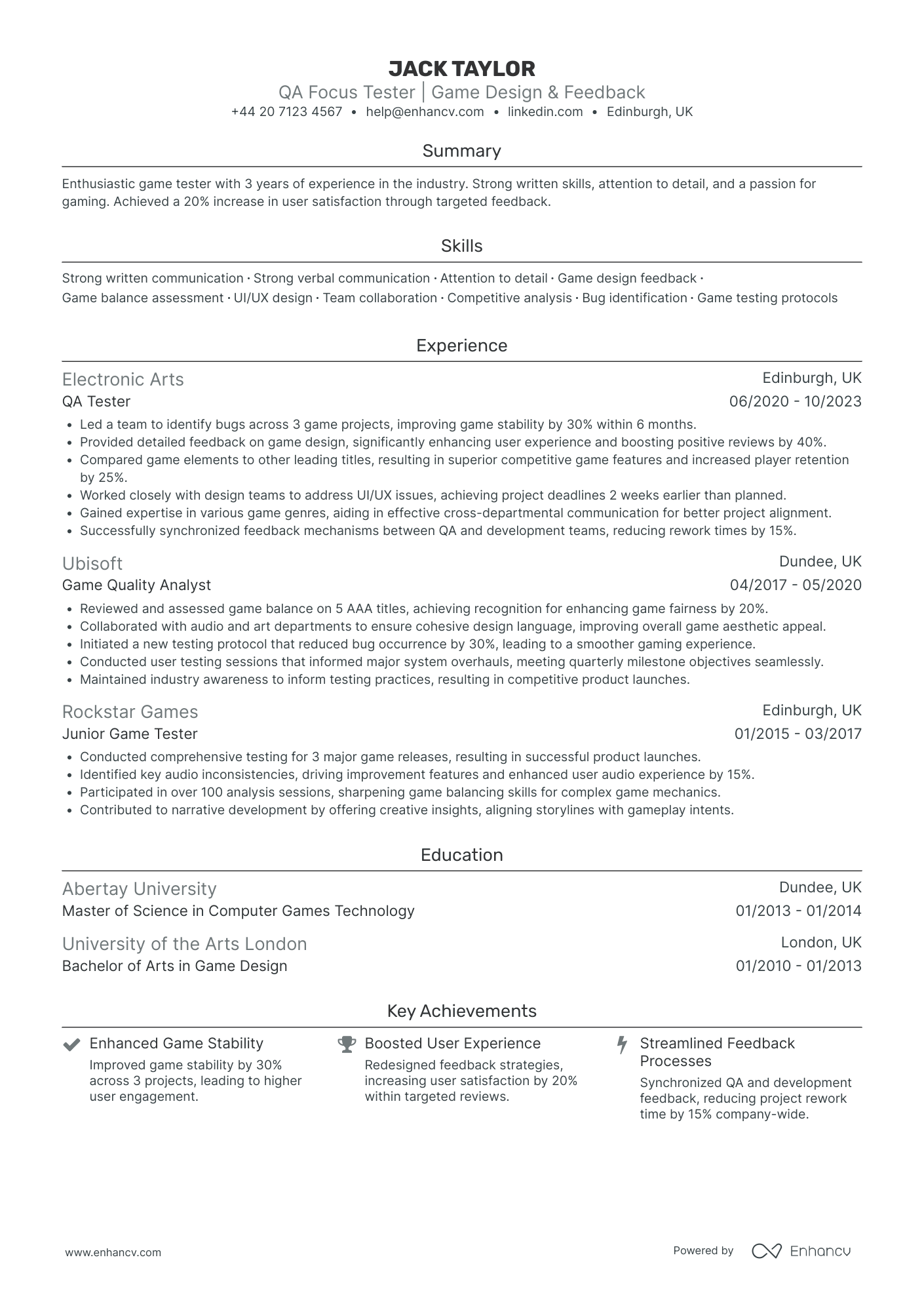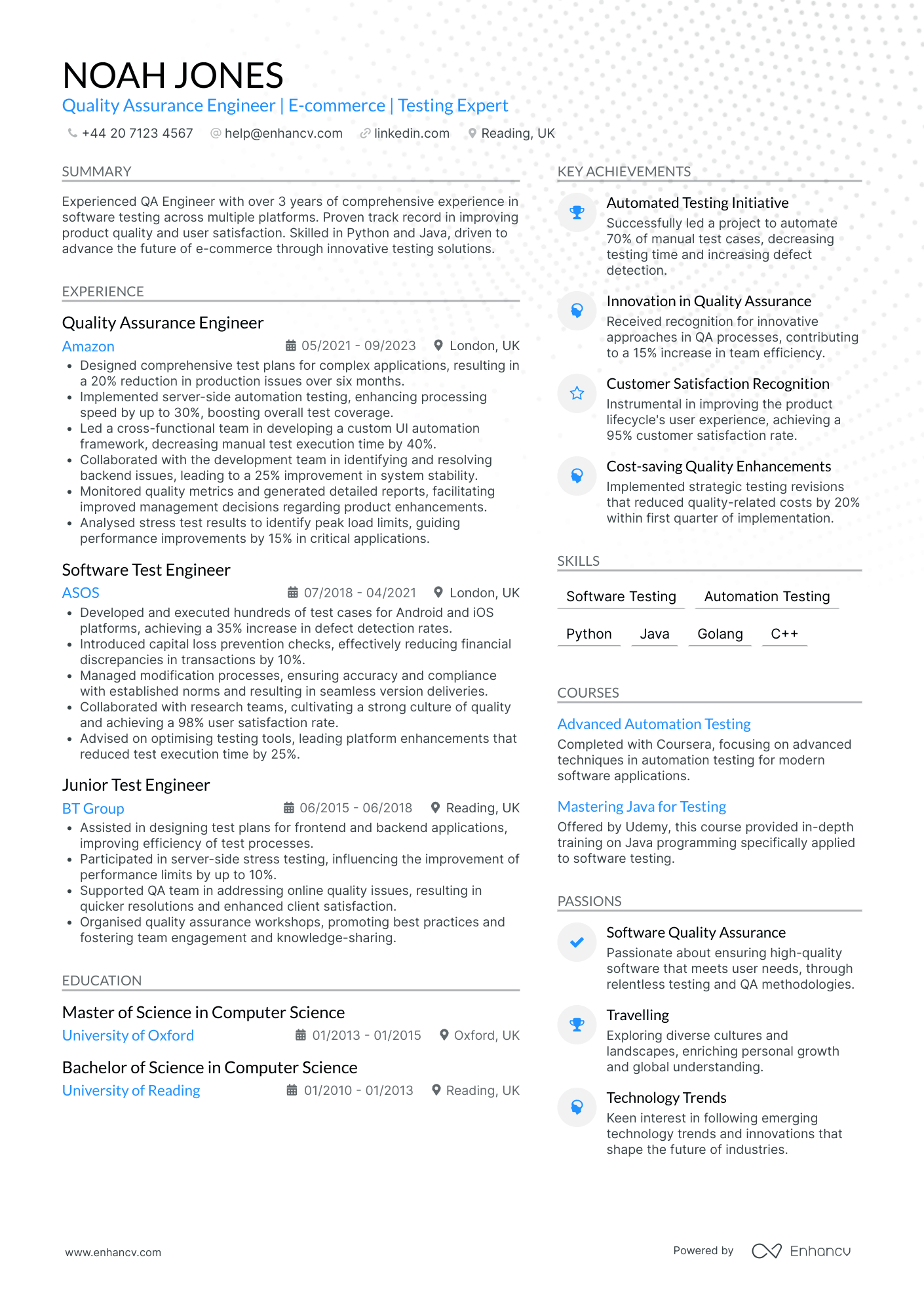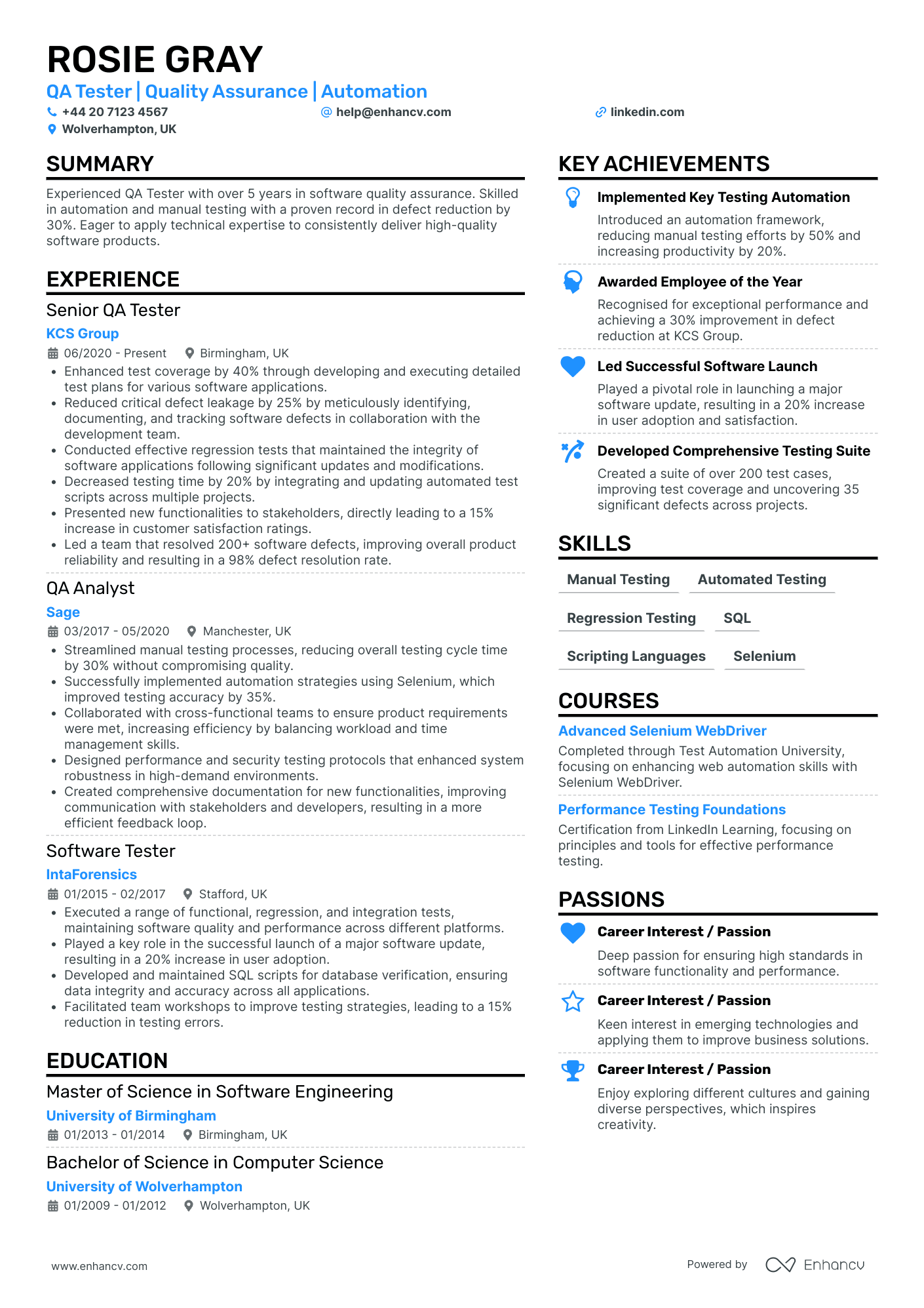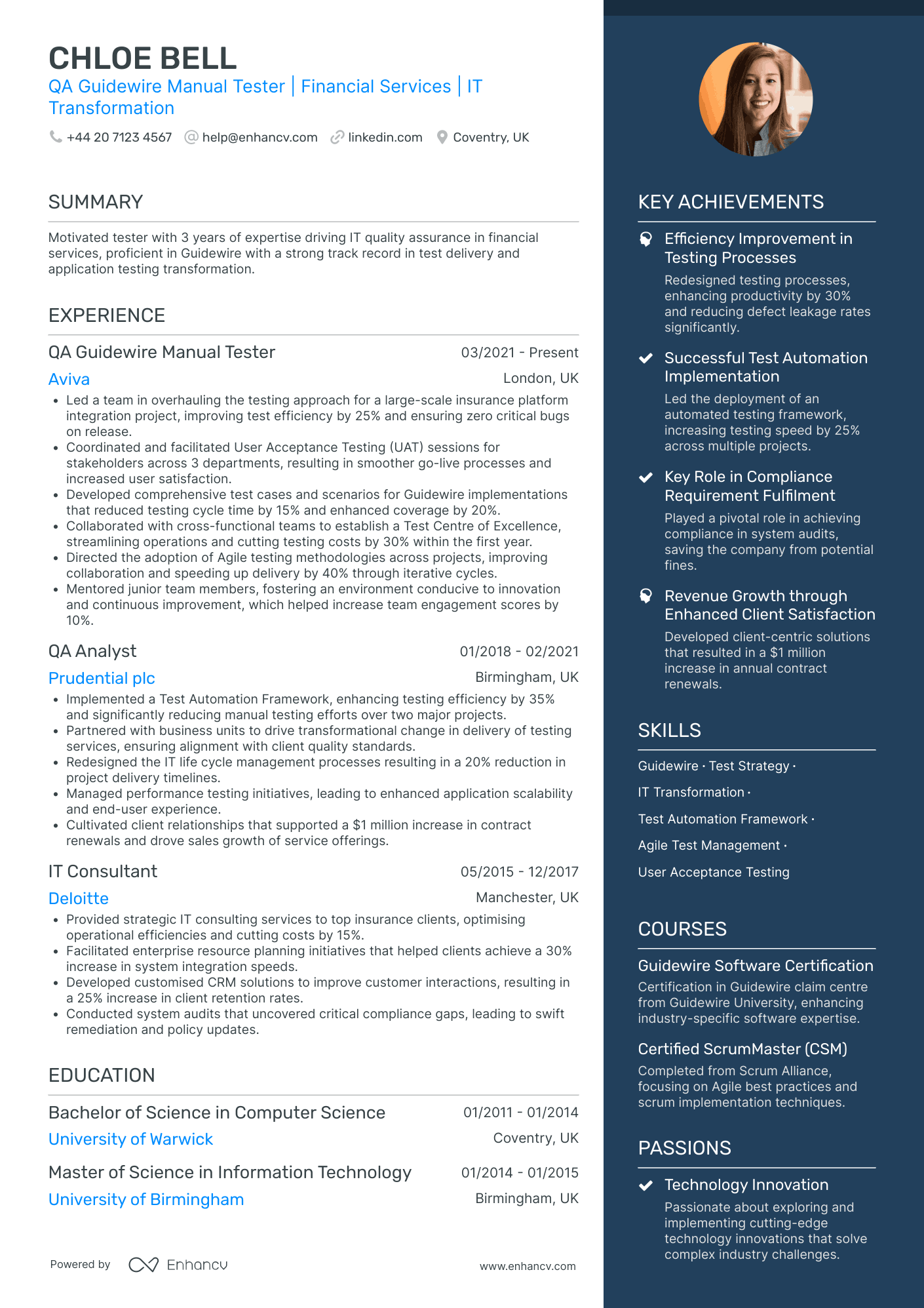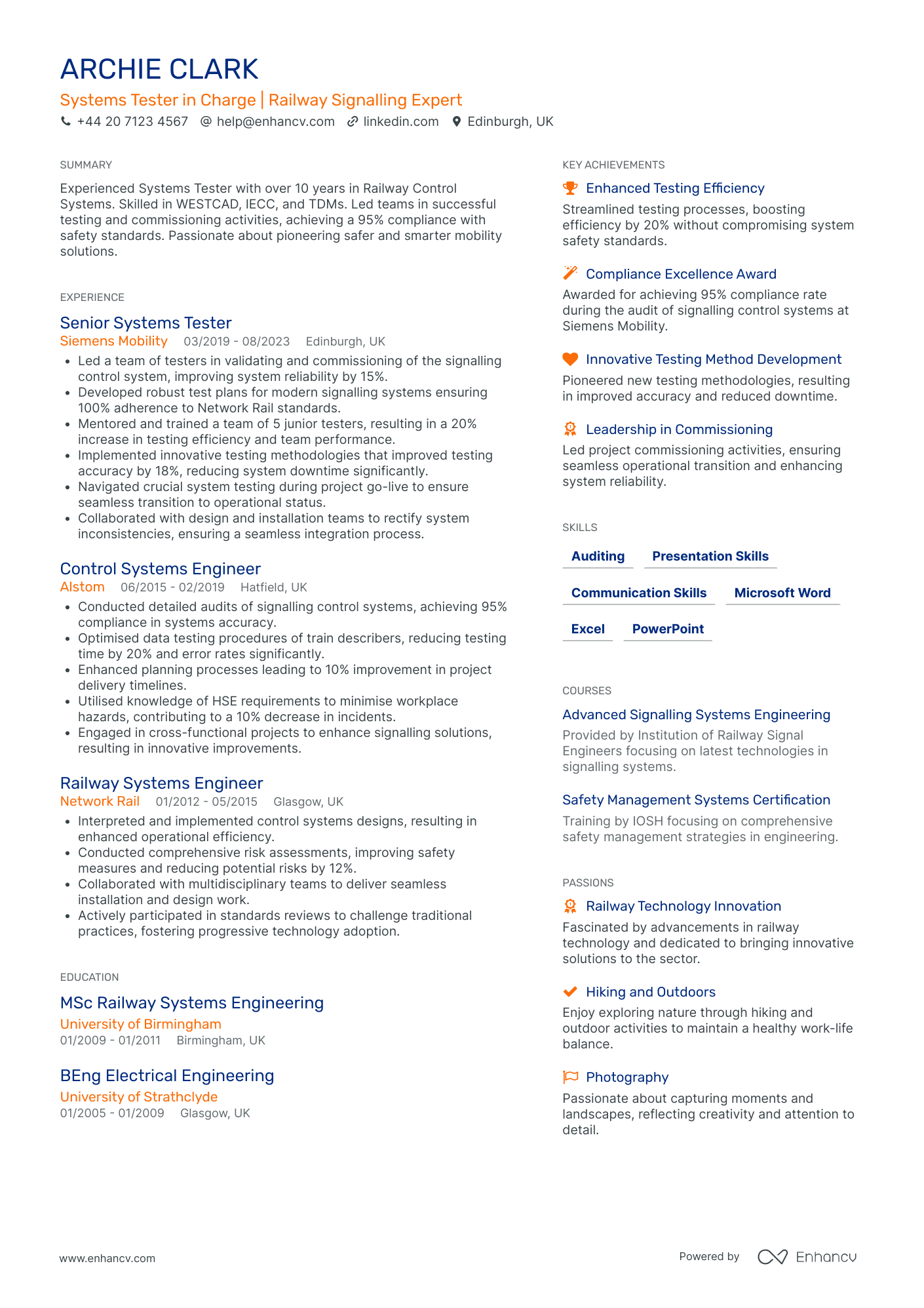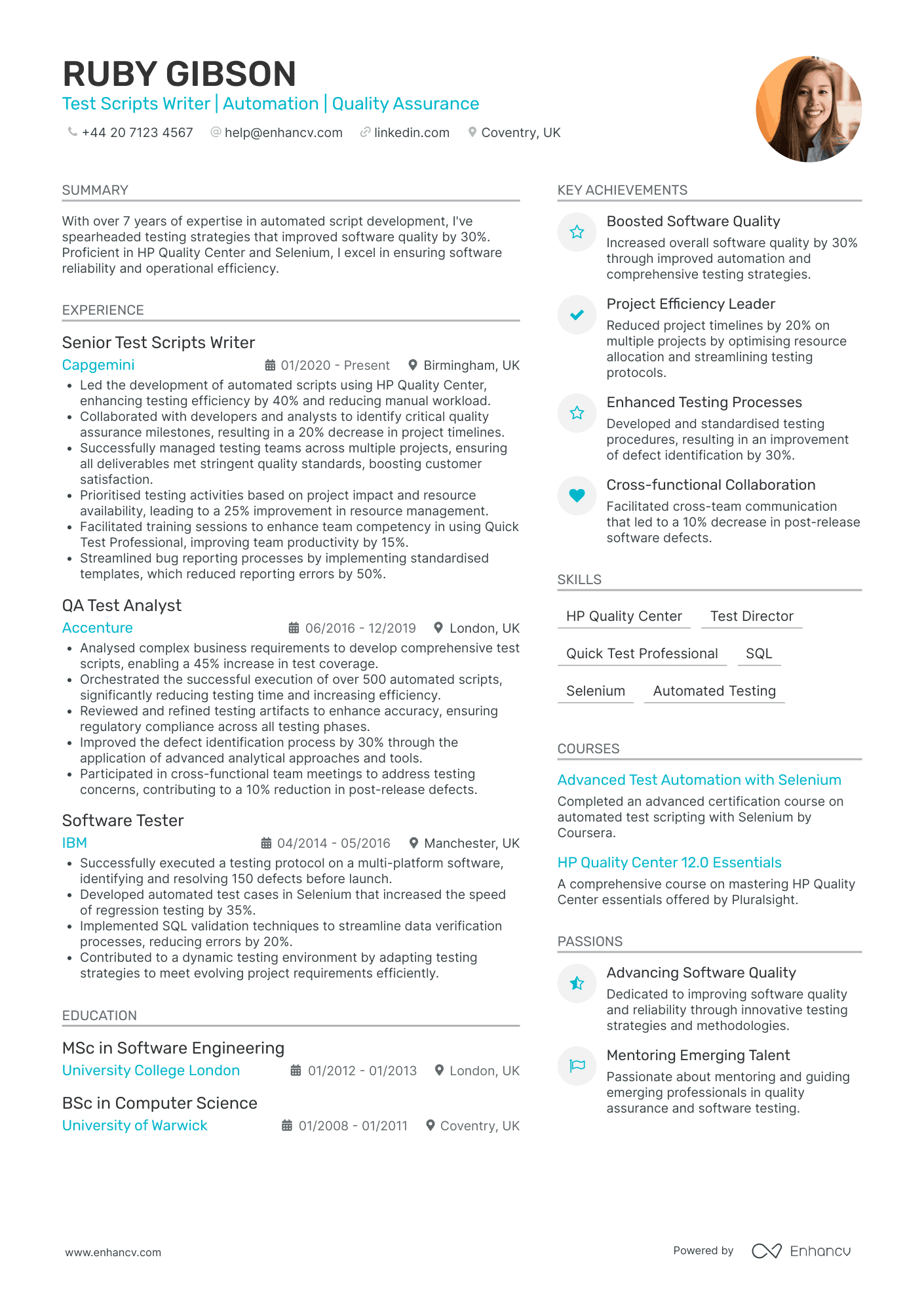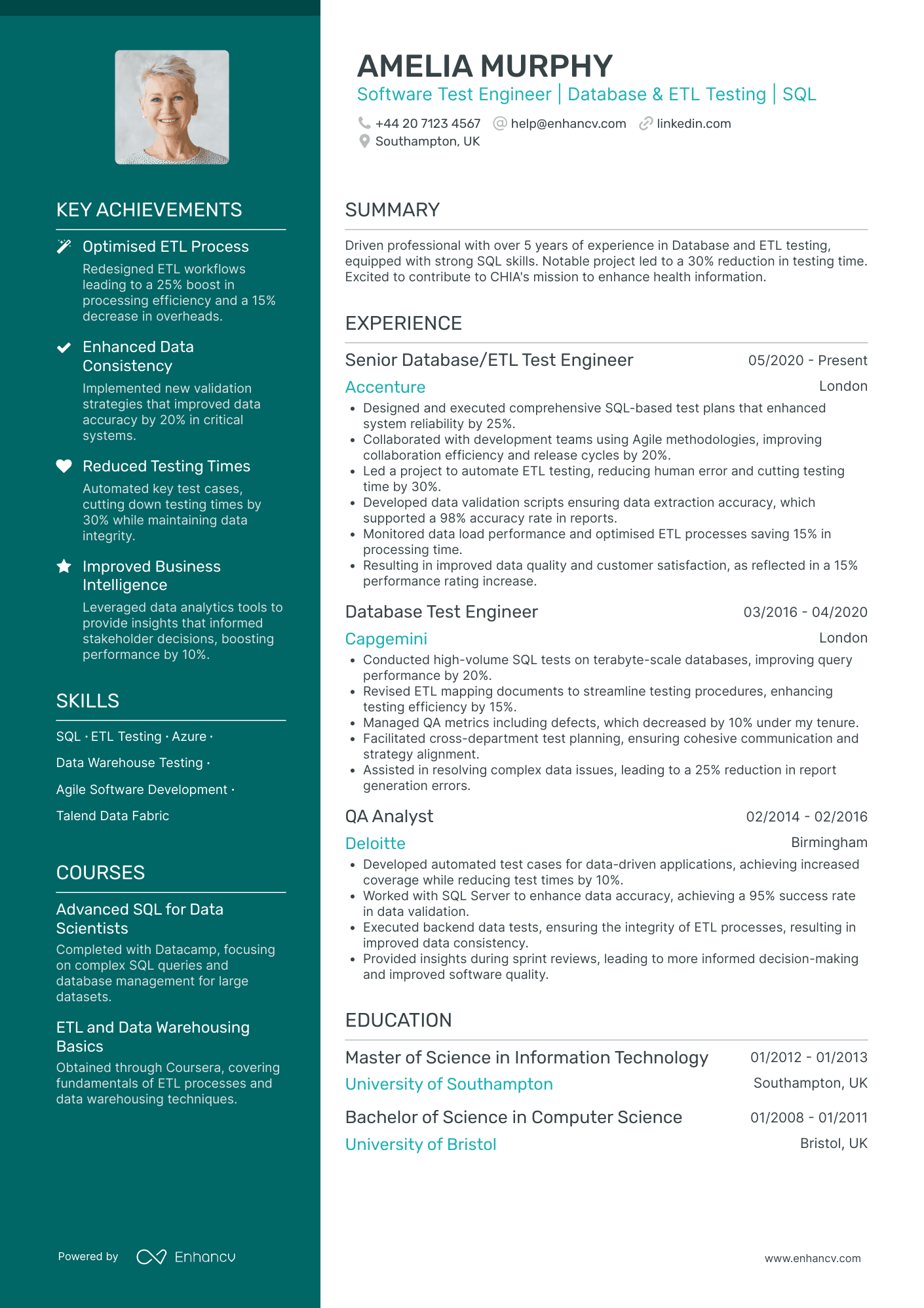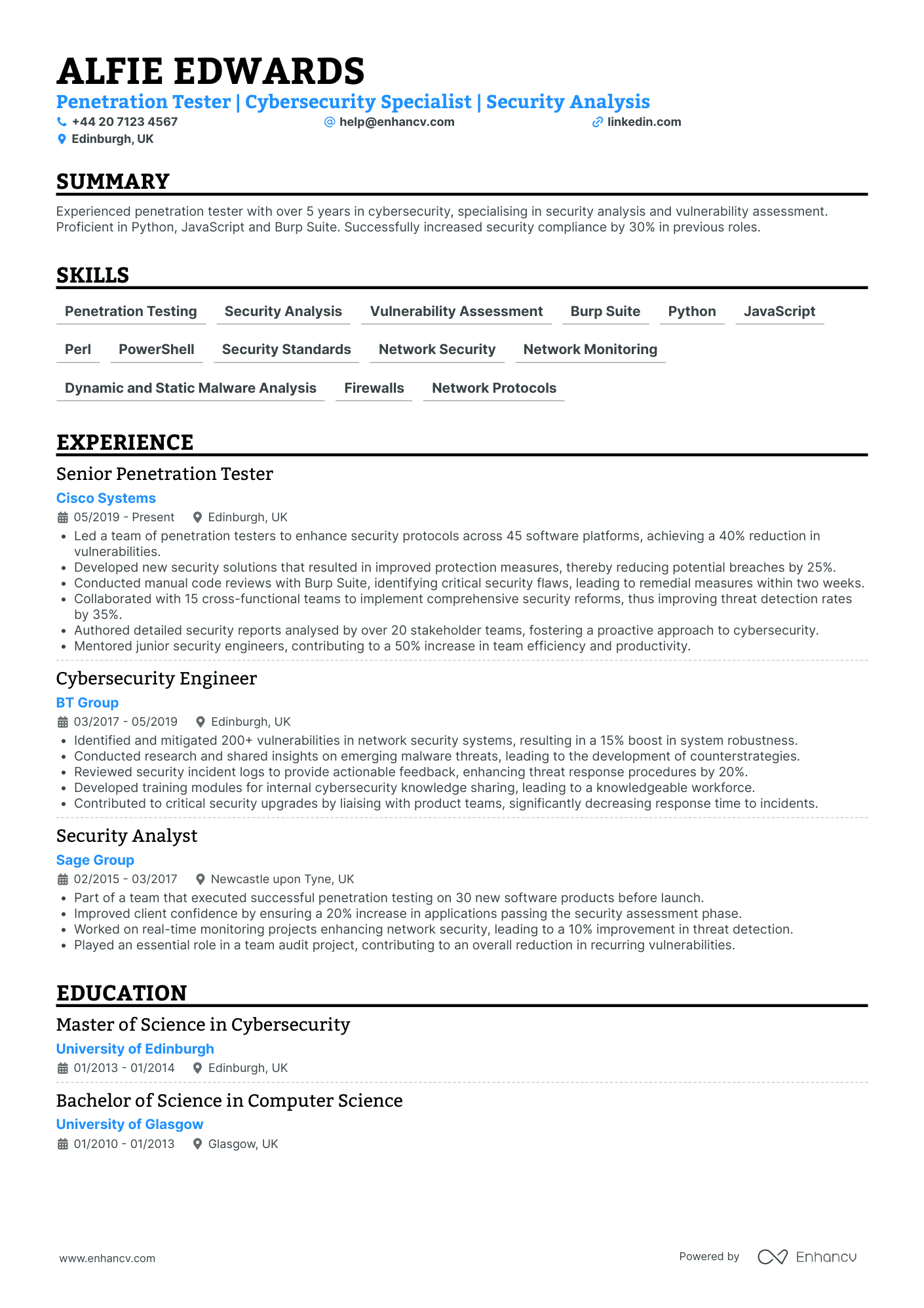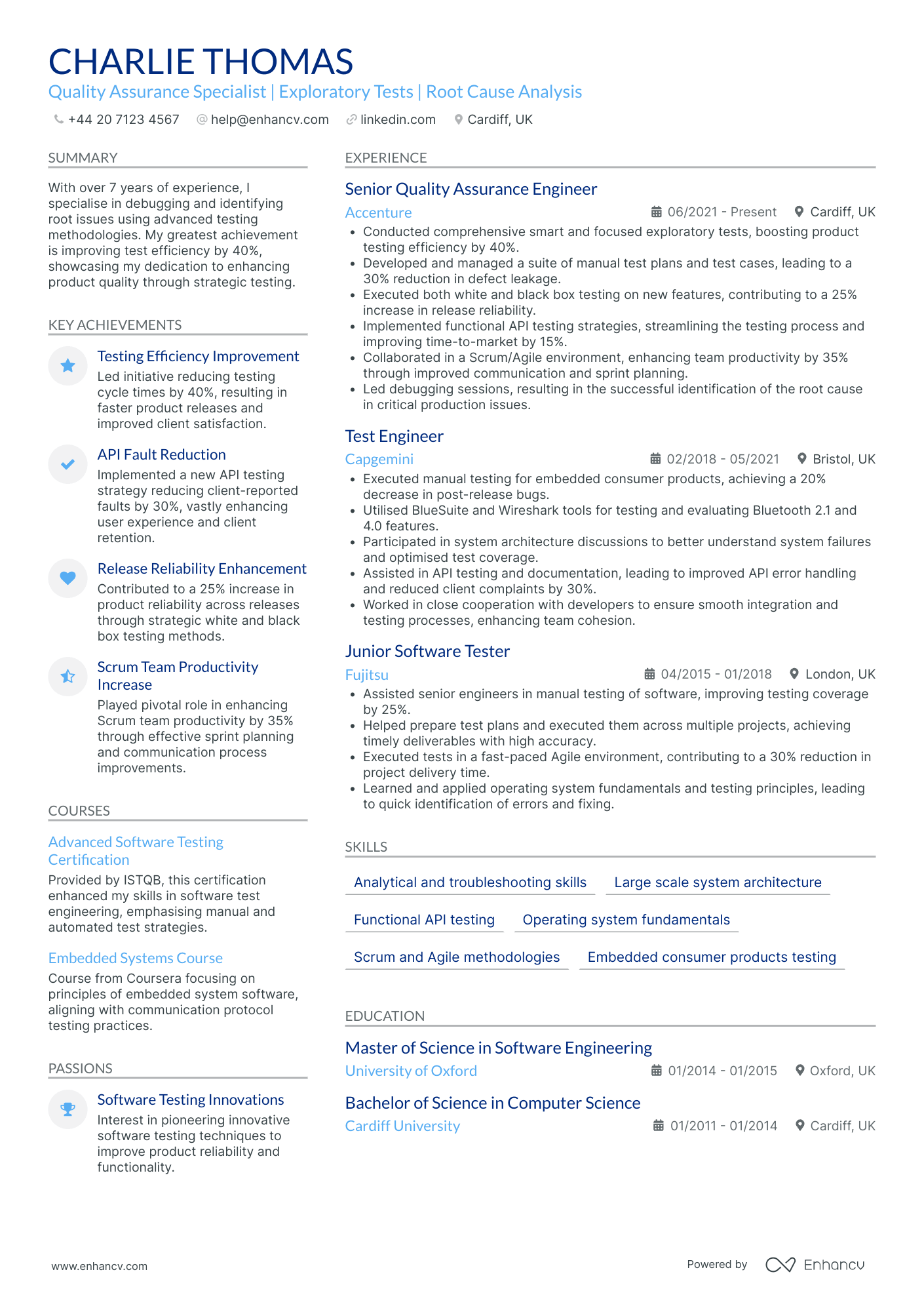One of the CV challenges you may encounter as a manual tester is crafting a resume that effectively showcases your attention to detail and hands-on testing skills. Our guide offers tailored advice and examples to help you highlight your expertise and make a strong impression on potential employers.
- Answer job requirements with your manual tester CV and experience;
- Curate your academic background and certificates, following industry-leading CV examples;
- Select from +10 niche skills to match the ideal candidate profile
- Write a more succinct experience section that consists of all the right details.
Do you need more specific insights into writing your manual tester CV? Our guides focus on unique insights for each individual role:
CV examples for manual tester
By Experience
Entry-Level Manual Tester
- Clarity and Structure - Chloe Bell's CV is presented in a clear, concise manner, ensuring each section is well-structured and easy to navigate. This allows for quick identification of her skills and achievements, which are particularly relevant to the role of a Junior QA Manual Tester.
- Career Trajectory - The CV details a consistent upward trajectory in Chloe's career, highlighting her progression from a Quality Assurance Specialist to a QA Manual Tester at BT Group. This growth is indicative of her expanding skill set and increasing responsibilities within the telecommunications industry.
- Unique Industry-Specific Elements - Chloe's use of specialized tools and methodologies, like ADB, Logcat, and Linux environments, underscores her technical depth. Her focus on LTE and connectivity testing demonstrates a strong alignment with industry-specific practices, which is vital for her role.
Senior Manual Tester
- Clear Content Presentation and Structure - The CV is well-organized, with clearly defined sections for education, experience, skills, and achievements. Each part presents pertinent information concisely, ensuring that the reader can easily access key details about the candidate's qualifications and career history. This clarity and structured approach make it simple to identify the candidate's fit for the role quickly.
- Strong Career Trajectory Demonstrating Growth - The career path depicted in this CV shows a steady progression from a Software Test Engineer to a Senior Test Analyst, highlighting significant promotions and increased responsibilities over time. The candidate's movement through prominent companies such as Accenture and Capgemini evidences robust professional growth within the software testing industry.
- Emphasis on Automation and Leadership - The CV showcases the candidate's technical depth and leadership skills in automation testing. The mention of spearheading automation strategies, leading teams, and achieving a reduction in testing time and defects underlines a combination of technical expertise and strategic vision. Such emphasis on both hard and soft skills illustrates a leader capable of driving efficiency and quality improvements.
Junior Manual Tester
- Clarity and Structure in Content Presentation - The CV is exceptionally clear and well-structured, making it easy to navigate through Sophia Brooks' professional journey. Each section is neatly categorized and concise, facilitating a quick understanding of her qualifications and achievements without overwhelming the reader.
- Evidence of Early Career Advancement - Sophia Brooks' career trajectory shows impressive growth within a short span of two years. Starting as a Junior QA Tester and advancing to a lead QA Tester at GE Healthcare, it reflects her ability to rapidly grow and assume greater responsibilities in medical technology testing.
- Industry-Specific Technical Depth - The CV provides a deep insight into Sophia's expertise in niche industry-specific elements such as cardiac devices, HL7 data, and SQL-based systems, which underscores her technical proficiency and specialized knowledge in health informatics and medical technologies testing.
Lead Manual Tester
- Structured showcase of career progression - The CV excellently traces Isabella's career growth from a Test Analyst to a Quality Assurance Specialist, clearly highlighting how she advanced in her field while taking on increasing responsibilities. Her trajectory is well-documented with key positions at respected firms like Aviva, Capita, and Sky, showing a consistent upward movement and gaining of expertise in the QA field.
- Emphasis on technical expertise and industry-specific tools - Isabella's CV is rich with details on methodologies and tools specific to software testing, such as SDLC, JIRA, and HP ALM. Her proficiency in both Agile and Waterfall methodologies, along with specialized training in advanced testing techniques, demonstrates a deep technical understanding essential for a Quality Assurance Specialist.
- Leadership and mentorship capabilities - Beyond technical skills, Isabella's CV emphasizes her leadership qualities, particularly in mentoring junior QA testers. Her ability to elevate team performance by 15% reflects her effective leadership and mentorship skills, valuable assets in her ability to nurture talent and drive team success.
Mid-Level Manual Tester
- Structured and Comprehensive Presentation - Isabelle's CV is meticulously structured, providing clear sections that outline her extensive career in quality assurance. The content is concise and logically organized, making it easy for potential employers to understand her expertise and professional journey at a glance.
- Progressive Career Path - Isabelle demonstrates a consistent upward trajectory in her QA career. Starting as a Manual Tester, she advanced to QA Analyst and then to Quality Assurance Engineer, depicting growth in responsibility and skill application over time. Her career path shows significant industry experience in top IT companies, highlighting her growth and potential for future roles.
- Technical Prowess and Tool Mastery - Isabelle’s CV stands out with its emphasis on her proficiency with industry-specific tools like Selenium, ServiceNow, and Jira. Her ability to employ these tools in various automated and manual testing scenarios showcases her deep technical knowledge and adaptability in using advanced testing methodologies.
Principal Manual Tester
- Effective Content Presentation - The CV is well-structured and clear, providing a concise overview of the candidate's qualifications, skills, and experiences. Each section is logically organized with bullet points that highlight key achievements and responsibilities, making it easy for readers to extract relevant information quickly.
- Strong Career Trajectory - Isla King displays a notable career progression from a Junior QA Analyst to a Senior Manual QA Tester role, indicating growth and recognition in the field. The trajectory reflects her ability to take on increased responsibilities and successfully lead projects, hinting at qualities like dedication and professional development.
- Industry-Specific Expertise - The CV showcases deep technical knowledge in manual, end-to-end, and API testing. Important industry tools and methodologies are highlighted, such as defect-tracking systems and comprehensive testing plans, demonstrating her capability to enhance software quality and reliability through specialized skills.
Associate Manual Tester
- Career Trajectory - Samuel Campbell's CV reflects a strong career progression, with experience gained from reputable organizations like BAE Systems, Lockheed Martin, and Thales Group. Clearly, he has advanced from a Test Analyst to a Software Test Engineer, demonstrating continuous growth and accumulation of valuable skill sets in the software testing industry.
- Achievements and Business Relevance - The CV prominently features impactful achievements, such as leading initiatives that boosted automated testing integration and increased bug detection rates significantly. Each accomplishment is linked to tangible benefits like improved release times and enhanced product reliability, illustrating Campbell's effectiveness in contributing to business goals.
- Adaptability and Cross-Functional Experience - Through collaboration with cross-functional teams and managing stakeholder expectations, Samuel exhibits adaptability across various functions. His ability to streamline testing processes and articulate technical results to non-technical stakeholders further underscores his cross-departmental competence.
By Role
Manual Tester for Mobile Applications
- Content Presentation and Structure - The CV is structured clearly and concisely, breaking down complex roles and achievements into bullet points that enhance readability. Each section is well-organized, from experience to education, facilitating a smooth narrative flow that allows recruiters to quickly grasp the candidate’s qualifications and career progression.
- Career Progression and Industry Expertise - Olivia's career trajectory showcases a consistent upward movement, from a Software Tester to a Manual Test Engineer and then a Quality Assurance Analyst. This growth reflects increasing responsibilities and expertise, especially in Agile environments, indicating her ability to adapt and evolve in dynamic settings.
- Achievements Impact - The CV highlights substantial achievements with clear business relevance, such as improving application reliability by 30% and reducing testing cycle time by 25%. These accomplishments are not only quantified but explained in terms of impact on application performance and client satisfaction, demonstrating the candidate's value addition to the organization.
Manual Tester in Software Development
- Comprehensive career development - Joshua’s CV illustrates an impressive career trajectory with steady progress from a Software Tester at Wipro UK to a Senior QA Automation Engineer at Epic Systems. This advancement reflects growth in expertise and responsibility, indicating both dedication and proficiency in the QA field.
- Impressive technical toolkit - The CV highlights Joshua's expertise with industry-standard tools and methodologies, such as Selenium WebDriver, Jenkins, and Python. His proficiency in integrating automated testing into CI/CD pipelines showcases technical depth that is crucial for efficient test automation processes.
- Notable achievements with significant impact - Joshua's CV emphasizes the business relevance of his achievements, such as reducing post-release defects by 30% and enhancing test efficiency by 40%. These accomplishments demonstrate his ability to drive significant operational improvements within his projects, underscoring the real-world impact of his contributions.
Manual Tester for Web Services
- Structured and Clear Presentation - The CV is exceptionally well-structured, beginning with a concise summary that efficiently outlines the candidate's expertise. Each section flows logically, providing detailed yet precise information that is easy to navigate, making it evident for potential employers to assess Chloe's qualifications quickly and effectively.
- Consistent Career Growth - Throughout Chloe’s career, there is a clear trajectory of growth and responsibility. Starting as a Quality Assurance Analyst at IBM, she moved to a Test Engineer position at Capgemini and eventually advanced to a Senior Test Engineer role at BT Group. This progression highlights her ability to take on increasing levels of complexity and responsibility, indicating strong career advancement.
- Depth in Test Engineering Tools and Methodologies - Chloe’s work has been deeply immersed in industry-specific elements such as AWS, CI/CD pipelines, and agile methodologies. Her proficiency with tools like Python, Selenium, and JIRA demonstrates robust technical skills relevant to the field of test engineering, showcasing her comprehensive understanding of the tools and methodologies vital for modern testing solutions.
Manual Tester in Telecommunications
- Clear Presentation with Distinct Sections - Olivia Turner's CV is exceptionally well-structured, offering a seamless flow of information. It starts with a succinct summary, followed by organized sections such as experience, education, skills, courses, achievements, and interests, making it easy to navigate and understand her professional journey and qualifications in cybersecurity.
- Career Trajectory Reflects Consistent Advancement - Olivia's career progression demonstrates steady growth and expertise within the cybersecurity field. Her advancement from an Information Security Consultant to a Senior Penetration Tester highlights her dedication and capability to take on more complex roles, showcasing a professional journey that aligns perfectly with her industry aspirations.
- Emphasis on Measurable Achievements and their Impact - The CV underscores Olivia's ability to deliver tangible results, such as enhancing client web application security by 35% and reducing application vulnerability resolution times by 30%. These quantifiable accomplishments reflect not just her technical prowess but also her capacity to drive significant business improvements through her cybersecurity expertise.
Manual Tester for Video Games
- Clear and Structured Presentation - Jack Taylor's CV is organized in a way that allows for easy reading and understanding. Each section is clearly defined, from professional experience to education, making it straightforward for potential employers to find relevant information without getting lost in excessive detail.
- Impressive Career Progression - The career trajectory shows a steady growth in the gaming industry, moving from a Junior Game Tester to a QA Focus Tester at well-known companies like Rockstar Games, Ubisoft, and Electronic Arts. This progression highlights his increasing responsibilities and expertise, ultimately leading to his current role that integrates QA with game design feedback.
- Soft Skills and Leadership Qualities - The CV highlights Jack's leadership skills through his experience in leading teams to identify bugs and improving user satisfaction in games. His strong written and verbal communication skills are underscored, along with his ability to synchronize feedback across teams, showcasing his suitability for roles that require collaboration and leadership.
Manual Tester in E-commerce
- Structured Presentation of Career Progression - Noah’s CV is meticulously structured, clearly illustrating a progressive career from a Junior Test Engineer to a Quality Assurance Engineer at leading companies. This logical flow not only showcases their growth but also highlights their ability to take on increased responsibilities over time.
- Emphasis on Technical Proficiency and Methodologies - The document emphasizes Noah's extensive technical skill set through specific mentions of Python, Java, Golang, and C++. It also underlines his expertise in cutting-edge testing methodologies such as server-side automation, demonstrating his technical depth and commitment to enhancing e-commerce platforms.
- Demonstration of Leadership and Cross-functional Collaboration - The CV effectively illustrates Noah's leadership abilities with examples of managing cross-functional teams and leading innovative QA projects. It also highlights his proficiency in collaborating with development teams, which reflects his adaptability and capacity to work across various functions to achieve quality excellence.
Manual Tester for Desktop Applications
- Comprehensive overview with clear structure - The CV presents a well-structured layout with distinct sections including experience, education, skills, and more. This organization allows the reader to quickly navigate and understand the candidate's qualifications and career history, enhancing clarity and conciseness.
- Impressive career progression and expertise - Rosie's career trajectory demonstrates a clear growth path from Software Tester to Senior QA Tester roles, indicating continuous professional development and increasing responsibility in the field of software quality assurance.
- Effective use of industry-specific methodologies and tools - The CV highlights a range of technical proficiencies, such as automation with Selenium, regression testing, and the use of SQL, Test Complete, and Azure DevOps. These demonstrate a deep technical understanding and expertise in industry-standard tools and methodologies crucial for QA roles.
Manual Tester in Financial Services
- Comprehensive Career Progression in IT and Financial Services - Chloe Bell's CV showcases a clear trajectory of growth, beginning as an IT Consultant at Deloitte, advancing to QA Analyst at Prudential plc, and ultimately moving into a specialized role as a QA Guidewire Manual Tester at Aviva. This progression highlights her ability to adapt to different roles within the IT and financial services industries while continually expanding her expertise and responsibility.
- Strategic Use of Industry-Specific Technologies - The CV emphasizes Chloe's proficiency with Guidewire software, a critical tool in the financial services industry for insurance operations. Her certifications and demonstrated expertise in implementing Guidewire solutions underscore her technical depth, while her experience with Agile methodologies reflects a strong alignment with modern software development practices.
- Impactful Leadership and Collaboration Skills - Chloe's experience in leading teams, mentoring juniors, and establishing a Test Centre of Excellence at Aviva showcases her strong leadership abilities. Her collaboration with cross-functional teams to improve processes and her role in facilitating User Acceptance Testing sessions indicate her capability to drive projects forward effectively and improve team engagement, an essential quality for leadership in technology-driven industries.
Manual Tester for Network Systems
- Strategic Clarity and Structure - The CV is well-structured, presenting each section in a logical and concise manner, facilitating easy navigation. Clear headers and bullet points allow for quick assimilation of critical information, enhancing overall readability and impact.
- Consistent Career Growth - Archie Clark's career trajectory shows a steady progression from a Railway Systems Engineer to Senior Systems Tester, demonstrating expertise and commitment to professional development in the railway industry. This growth highlights a strong alignment with industry-specific advancements and increasing responsibilities.
- Industry-Specific Technical Proficiency - The CV impresses with its emphasis on unique industry tools and methodologies such as WESTCAD, IECC, and TDMs, showcasing a deep technical acumen and relevancy to railway signalling and control systems engineering that is highly sought after in the market.
Manual Tester in Healthcare Technology
- Clear and Structured Content Presentation - The CV is noteworthy for its organized and concise presentation. It starts with a succinct summary that highlights the candidate's seven years of automated script development expertise, making an immediate impression of credibility and competence. The experience section is well-structured, presenting accomplishments and responsibilities in bullet points for easy comprehension, ensuring the reader quickly grasps the candidate’s key contributions and skills.
- Impressive Career Trajectory - Ruby Gibson's career progression is a testament to her growing expertise in quality assurance. Beginning as a Software Tester at IBM, she advanced to a QA Test Analyst at Accenture and ultimately achieved a senior role at Capgemini. This upward trajectory signifies not only her capability to take on more complex responsibilities but also her ability to adapt and excel across various esteemed organizations, highlighting her professional growth and dedication.
- Sector-Specific Technical Proficiency - The CV showcases strong industry-specific elements, such as proficiency in HP Quality Center and Selenium, tools that are crucial for automation and quality assurance roles. These mentions indicate deep technical knowledge and specialization in automated testing tools and methodologies, reinforcing her ability to bring technical depth and innovation to testing processes and ensuring software reliability and efficiency.
Manual Tester for Database Systems
- Clarity and Structure in Presentation - The CV is organized with clear headings and concise bullet points, making it easy for employers to navigate through the professional experiences and skills. The use of specific dates and locations also provides a coherent timeline of Amelia's career progression.
- Growth and Industry Expertise - Amelia's career trajectory shows a steady progression from a QA Analyst to Senior Database/ETL Test Engineer at Accenture, demonstrating growth and an increasing level of responsibility over the years. Her consistent focus on database and ETL testing across top firms highlights her strong expertise in the industry.
- Impactful Achievements with Business Relevance - The CV effectively showcases Amelia's contributions to her employers with metrics-driven achievements such as a 30% reduction in testing time and a 15% improvement in customer performance ratings, highlighting her ability to deliver results that directly benefit business operations.
Manual Tester in Cybersecurity
- Structured and concise presentation - The CV is well-organized, with clear sections highlighting skills, experience, education, and achievements. The concise bullets under each role effectively communicate the candidate's contributions and impact without overwhelming details, ensuring readability and engagement from potential employers.
- Demonstrated career growth and responsibility - Alfie Edwards's career trajectory showcases a consistent rise in responsibility from a Security Analyst to a Senior Penetration Tester, indicating a strong work ethic and a commitment to growing within the cybersecurity field. The progression is coupled with evidence of leadership and project management, enhancing his profile in the competitive cybersecurity industry.
- Specialized tools and methodologies - The inclusion of specific cybersecurity tools such as Burp Suite, along with proficiency in Python and JavaScript, highlights the candidate’s technical depth and expertise in industry-specific methodologies. This technical proficiency is crucial for a penetration tester, underscoring the candidate’s ability to handle advanced security challenges effectively.
Manual Tester for Embedded Systems
- Structured Career Progression - Charlie Thomas's CV exhibits a clear career trajectory reflecting growth and advancement in the quality assurance field. Starting as a Junior Software Tester and progressing to a Senior Quality Assurance Engineer, each role has built upon the last, demonstrating a consistent dedication to mastering expertise and expanding responsibility, particularly in leadership and test management.
- Integration of Advanced Testing Tools and Methodologies - This CV impresses with the depth of technical expertise and specialization in industry-relevant tools such as BlueSuite and Wireshark. Charlie's adept use of both white and black box testing, along with advanced API testing strategies, emphasizes an industry-specific proficiency that is crucial for a Quality Assurance Specialist.
- Significant Impact Through Tangible Achievements - Throughout the document, Charlie highlights impactful achievements in a way that goes beyond numbers to underscore business relevance. Key accomplishments such as boosting product testing efficiency by 40% and reducing API client-reported faults by 30% illustrate a strong ability to enhance processes and contribute to overall business success, underscoring their effectiveness and strategic thinking.
Structuring your manual tester CV layout: four factors to keep in mind
There are plenty of best practices out there for your CV layout and design. At the end of the day, a clear format and concise CV message should be your top priority. Use your CV design to enhance separate sections, bringing them to the forefront of recruiters' attention. At the same time, you can write content that:
- Follows the reverse chronological order in the experience section by first listing your most recent jobs;
- Incorporates your contact information in the header, but do skip out on the CV photo for roles in the UK;
- Is spotlighted in the most important sections of your CV, e.g. the summary or objective, experience, education, etc. to show just how you meet the job requirements;
- Is no longer than two-pages. Often, the one-page format can be optimal for your manual tester CV.
Before submitting your CV, you may wonder whether to export it in Doc or PDF. With the PDF format, your information and layout stay intact. This is quite useful when your CV is assessed by the Applicant Tracker System (or the ATS) . The ATS is a software that scans your profile for all relevant information and can easily understand latest study on the ATS , which looks at your CV columns, design, and so much more.

PRO TIP
Be mindful of white space; too much can make the CV look sparse, too little can make it look cluttered. Strive for a balance that makes the document easy on the eyes.
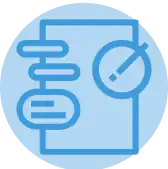
The top sections on a manual tester CV
- Work experience in testing demonstrates practical knowledge.
- Testing certifications show commitment to professional growth.
- Technical skills section outlines proficiency with test tools.
- Key projects section highlights notable achievements.
- Education background establishes foundational knowledge.
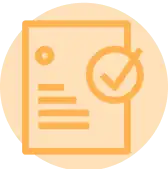
What recruiters value on your CV:
- Emphasize your keen attention to detail and patience, highlighting experiences where meticulous testing processes led to the identification and resolution of software defects.
- Document your proficiency with various testing techniques such as exploratory testing, black-box testing, and regression testing, demonstrating a well-rounded manual testing skill set.
- Showcase your proficiency with test management tools (like JIRA, TestRail, or Quality Center) and how you've utilised them for test case creation, execution, and defect tracking.
- Highlight soft skills such as communication and teamwork, providing examples of effectively collaborating with developers and QA teams to enhance product quality.
- Include experiences with different testing environments and platforms (like mobile, desktop, web) to show your adaptability and ability to handle diverse testing scenarios.
Recommended reads:
What information should you include in your manual tester CV header?
The CV header is potentially the section that recruiters would refer to the most, as it should include your:
- Contact details - your professional (non-work) email address and phone number;
- Professional photograph - if you're applying hinting at the value you bring as a professional.
Many professionals often struggle with writing their manual tester CV headline. That's why in the next section of this guide, we've curated examples of how you can optimise this space to pass any form of assessment.

Examples of good CV headlines for manual tester:
"Manual QA Analyst | ISTQB Certified | Cross-platform Testing | Agile Methodologies | 3+ Years"
"Junior Test Engineer | Functional Testing Expertise | UI/UX Focus | Keen on Automation Learning | 2 Years"
"Senior Test Specialist | System Integration | Test Planning Pro | Risk Management | 8+ Years Experience"
"Lead Software Tester | Quality Assurance Strategies | Mentorship Role | Performance Testing | 10 Years"
"QA Consultant | Usability Testing | Requirement Analysis | Continuous Improvement Advocate | 5 Years"
"Quality Analyst | Regression & Smoke Testing | Detail-driven | Certified Agile Tester | 4 Years"
Opting between a manual tester CV summary or objective
Within the top one third of your manual tester CV, you have the opportunity to briefly summarise your best achievements or present your professional goals and dreams. Those two functions are met by either the CV summary or the objective.
- The summary is three-to-five sentences long and should narrate your best successes, while answering key requirements for the role. Select up to three skills which you can feature in your summary. Always aim to present what the actual outcomes were of using your particular skill set. The summary is an excellent choice for more experienced professionals.
- The objective is more focused on showcasing your unique value as a candidate and defining your dreams and ambitions. Think about highlighting how this current opportunity would answer your career vision. Also, about how you could help your potential employers grow. The objective matches the needs of less experienced candidates, who need to prove their skill set and, in particular, their soft skills.
Still not sure about how to write your CV opening statement? Use some best industry examples as inspiration:

CV summaries for a manual tester job:
- With over 5 years of hands-on experience in manual software testing and a proven track record of improving product quality, this meticulous tester has successfully identified and resolved countless bugs within multifaceted environments using tools like JIRA and Selenium. Their achievement in boosting defect detection rates by 30% attests to their dedication and expertise.
- A seasoned IT professional with 10 years in system administration now transitioning into manual testing brings a deep understanding of network infrastructures and software development cycles. Mastered test case creation and excels in finding critical system flaws through rigorous analysis, enhancing overall software integrity for previous employers.
- Recently pivoted from a successful 8-year career in quality assurance for manufacturing to manual software testing, this individual offers a unique perspective on process efficiency and continuous improvement. Keen problem-solving skills, detail-orientation, and adaptability make them a potential asset in uncovering software anomalies.
- Adept at utilizing strengths in data analysis and UX design principles, a former digital marketer with 4 years of experience pivots their career towards manual software testing. Committed to leveraging their extensive background in customer experience to enhance the usability and functionality of software products in a new technological setting.
- Eager to embark on a career in manual testing, a recent computer science graduate possesses a solid foundation in coding languages such as Java and Python, coupled with a fervent interest in software development. Determined to contribute fresh insights and a strong commitment to learn and grow within a dynamic testing environment.
- University graduate with a BSc in Information Technology, pursuing the opportunity to apply a strong academic background and comprehensive understanding of software development life cycle in a manual software testing capacity. Enthusiastically seeking to develop hands-on testing skills and contribute to the delivery of high-quality software applications.
More detailed look into your work history: best advice on writing your manual tester CV experience section
The CV experience is a space not just to merely list your past roles and responsibilities. It is the CV real estate within which you could detail your greatest accomplishments and skills, while matching the job requirements. Here's what to have in your experience section:
- Prove you have what the job wants with your unique skill set and past successes;
- Start each bullet with a strong, action verb, and continue with the outcome of your responsibility;
- Use any awards, nominations, and recognitions you've received as solid proof of your skill set and expertise;
- align your experience with the role responsibilities and duties.
For more help on how to write your CV experience section, check out the next section of our guide:

Best practices for your CV's work experience section
- Executed over 450 manual test cases for web and mobile applications, ensuring applications met functional requirements and user expectations.
- Developed comprehensive test plans and cases based on product specifications and user stories, improving test coverage by 25%.
- Successfully identified, documented, and reported 300+ bugs and defects in a variety of software environments, employing effective communication with the development team.
- Implemented a new test case management tool, leading to a 15% increase in test execution efficiency and improved tracking of test results.
- Participated in daily stand-ups and agile sprint planning, providing valuable feedback and updates on testing progress and challenges.
- Conducted thorough usability testing for a major e-commerce site’s checkout process, which increased conversion rates by 5% after improvements were made.
- Worked closely with product managers and developers to refine acceptance criteria for new features, ensuring alignment with business objectives and customer needs.
- Led a team of junior testers in a high-stakes project, providing mentorship and quality assurance guidance that helped maintain a defect escape rate of less than 2%.
- Organised and facilitated cross-functional bug triage meetings, streamlining defect prioritisation, and fostering collaboration between QA, development, and product teams.
- Executed comprehensive manual testing for web-based applications, improving defect detection rates by 30% through meticulous test case planning and execution.
- Facilitated a successful migration of the user database by conducting manual data validation, ensuring 99.9% data integrity post-migration.
- Collaborated with cross-functional teams during the Agile development cycle, enhancing the overall quality of the final product.
- Orchestrated an extensive user acceptance testing (UAT) phase which reduced post-launch critical issues by 40%.
- Pivoted testing strategies by incorporating usability testing, which increased user satisfaction metrics by 25% according to post-deployment surveys.
- Led a team of junior testers, overseeing the quality assurance of 15+ mobile applications, significantly decreasing the average bug turnaround time.
- Performed end-to-end system test procedures for a major banking software overhaul, leading to a 20% increase in system reliability and performance.
- Reduced the regression testing cycle time by 50% through the implementation of organized and reusable test suites.
- Championed the adoption of risk-based testing approach, efficiently prioritising test efforts on critical functionality areas.
- Drove the test effort for a new e-commerce platform, resulting in a successful launch with a transaction accuracy of 99.97%.
- Initiated a peer review test process which heightened the team's error detection capabilities early in the development stages.
- Implemented a structured defect tracking mechanism that improved developer-tester communication and reduced average bug resolution times by 35%.
- Conducted in-depth testing of complex CRM systems, contributing to an increase in user adoption rate by 20% within the first year.
- Proactively identified potential usability concerns that led to several critical user interface improvements before product release.
- Mastered various testing tools, diversifying testing techniques and empowering the team to cover more ground in shorter timeframes.
- Delivered detailed and effective test scenarios for a high-profile government software project, ensuring 100% compliance with functional requirements.
- Efficiently managed testing schedules and resources by leveraging test prioritisation principles, ensuring timely delivery of milestones.
- Actively contributed to weekly project status meetings, providing insights from a testing perspective that were critical to decision-making processes.
- Successfully completed manual testing for various mobile app versions, with each subsequent release experiencing a 10% reduction in critical bugs.
- Developed detailed defect reports which provided developers with actionable steps, increasing the efficiency of the debug process.
- Participated in the design of test strategies that ensured comprehensive coverage of all test cases within tight deadlines.
- Spearheaded the manual testing team for a multimillion-pound Fintech application, recording zero high-priority defects at product launch.
- Mentored junior testers, developing their skills which led to a 15% increase in team productivity and test coverage.
- Initiated a comprehensive weekly report system that highlighted key testing metrics, providing stakeholders with actionable insights into the testing progress.
Swapping your professional experience (when you have none) with skills and more
Never underestimate the importance of relevancе when it comes to your manual tester CV. Even if you don't happen to have much or any standard (full-time contract) professional experience, this doesn't mean you shouldn't apply for the role. Instead of a bespoke CV experience section:
- Showcase more prominently any internships, part-time roles, and volunteer experience that are applicable to the role and have taught you job-crucial skills;
- Feature a strengths or achievements section with your transferrable skills or talents you've obtained thanks to your work or life experience;
- Write an objective statement that clearly outlines your values as a candidate and defines your career ambitions;
- List your education or certificates that match the job profile closer to the top of your CV.
Recommended reads:

PRO TIP
If applicable, briefly mention a situation where things didn’t go as planned and what you learned from it, demonstrating your ability to learn and adapt.
Key manual tester CV skills: what are hard skills and soft skills
Let's kick off with the basics. You know that you have to include key job requirements or skills across your CV. For starters, take individual skills from the job description and copy-paste them into your CV, when relevant. Doing so, you'll ensure you have the correct skill spelling and also pass the Applicant Tracker System (ATS) assessment. There are two types of skills you'll need to include on your CV:
- Hard skills - technical abilities that are best defined by your certificates, education, and experience. You could also use the dedicated skills section to list between ten and twelve technologies you're apt at using that match the job requirements.
- Soft skills - your personal traits and interpersonal communication skills that are a bit harder to quantify. Use various CV sections, e.g. summary, strengths, experience, to shine a spotlight on your workspace achievements, thanks to using particular soft skills.
Remember that your job-winning CV should balance both your hard and soft skills to prove your technical background, while spotlighting your personality.
Top skills for your manual tester CV:
Test Case Creation
Test Execution and Reporting
Bug Reporting and Tracking
Functional Testing
Regression Testing
Cross Browser Testing
Black Box Testing
User Interface Testing
Performance Testing
SQL
Attention to Detail
Critical Thinking
Problem Solving
Effective Communication
Time Management
Adaptability
Collaboration and Teamwork
Learning Agility
Patient and Persistent
Organisational Skills

PRO TIP
If you have received professional endorsements or recommendations for certain skills, especially on platforms like LinkedIn, mention these to add credibility.
Education and more professional qualifications to include in your manual tester CV
If you want to showcase to recruiters that you're further qualified for the role, ensure you've included your relevant university diplomas. Within your education section:
- Describe your degree with your university name(-s) and start-graduation dates;
- List any awards you've received, if you deem they would be impressive or are relevant to the industry;
- Include your projects and publications, if you need to further showcase how you've used your technical know-how;
- Avoid listing your A-level marks, as your potential employers care to learn more about your university background.
Apart from your higher education, ensure that you've curated your relevant certificates or courses by listing the:
- name of the certificate or course;
- name of the institution within which you received your training;
- the date(-s) when you obtained your accreditation.
In the next section, discover some of the most relevant certificates for your manual tester CV:

PRO TIP
Use mini case studies or success stories in your CV to demonstrate how your skills have positively impacted previous roles or projects.
Recommended reads:
Key takeaways
What matters most in your manual tester CV-writing process is for you to create a personalised application. One that matches the role and also showcases your unique qualities and talents.
- Use the format to supplement the actual content, to stand out, and to ensure your CV experience is easy to comprehend and follows a logic;
- Invest time in building a succinct CV top one third. One that includes a header (with your contact details and headline), a summary or an objective statement (select the one that best fits your experience), and - potentially - a dedicated skills section or achievements (to fit both hard skills and soft skills requirements);
- Prioritise your most relevant (and senior) experience closer to the top of your CV. Always ensure you're following the "power verb, skill, and achievement" format for your bullets;
- Integrate both your technical and communication background across different sections of your CV to meet the job requirements;
- List your relevant education and certificates to fill in gaps in your CV history and prove to recrutiers you have relevant technical know-how.
